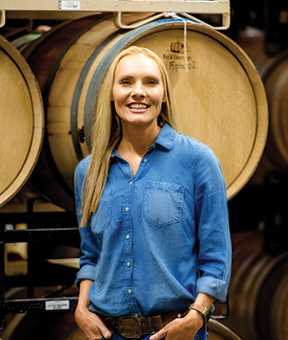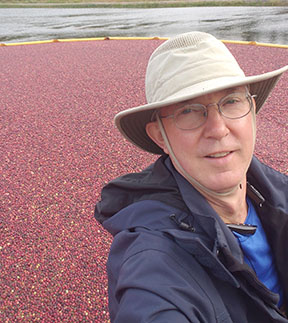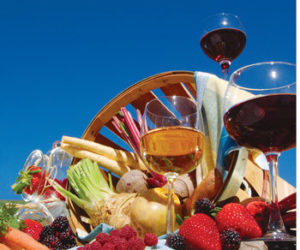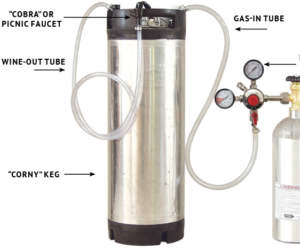Highlighting multiple fruits in a wine often brings more complex flavors and aromas to a bottle. There are multiple ways to make these wines — primarily fermenting fruits together or blending single-fruit wines after fermentation. Two pros share their own techniques for these delectable summer sippers.
Sandi Vojta, Founder & Winemaker at Prairie Berry Winery, Hill City, South Dakota

Some of my favorite fruit blends that I enjoy working with are raspberry and rhubarb or strawberry and rhubarb. Both raspberry and strawberry work great with rhubarb in that they balance out the earthiness typically associated with rhubarb without overpowering it completely. The beauty of these blends is that you can finish your residual sugar and acidity just about anywhere as long as you pay attention to balance. If the acidity is above 1.0 g/L I will typically finish the wine with 4–6% residual sugar.
I really feel it is important for drinkers to be able to taste the fruit in wine. For example if I am making a strawberry apple wine, I want to make sure they can taste both fruits. That may mean 25% strawberry and 75% apple in order to maintain both fruit characteristics. This is where pre-fermentation blend trials come in handy if fermenting both fruits together. Blending fruit juice prior to fermentation will get you in the ballpark of what the finished wine will be.
I have co-fermented fruits as well as fermented individual fruit wines and then blended post-fermentation to make fruit blends. I will co-ferment fruits together if they work better together early on in the process. Usually what determines a co-ferment is if I am working with a high-acid fruit and a low-acid fruit. I like to utilize the natural acid in the high-acid fruit to balance out the low-acid fruit. I prefer to use Mother Nature as much as possible. My winemaking style really shoots for minimal messing with fruit wine acidity. I prefer to not lower acidity via amelioration or potassium carbonate. If I am making a dry wine from a high-acid fruit, I will utilize a very small amount of sugar to balance it before package.
In addition to fruit flavor and acidity, I like to be considerate of the colors different fruits may lend to wine blends. Color can be just as important to how a wine tastes.
When it comes to blending fruits and grapes in wine I will look at the characteristics of the grape and fruit to determine if they will work well together. For example, a Zinfandel wine can have blueberry undertones. Why not play off of that and throw in some actual blueberries? Here again with these wines I feel that it is really important to maintain characteristics of both grape and fruit. I also select a yeast that brings out the attributes I am looking for in the grape while working well with the fruit also. Making a solid choice for fruit/grape combinations that ferment well together usually end well together.
If working with high-acid fruit I utilize a higher percentage of grapes to balance out the acidity. This allows for very little if any acidity adjustments. These wines are finished with a lower acidity and a little dryer, so less sugar may be needed for balancing.
For home winemakers considering a fruit/grape blend, my best advice is to have fun experimenting. You are not going to do anything wrong. Some blends may work better than others. Drink them, learn, and try again.
Keith Bishop, Co-Owner and Winemaker of Bishop’s Orchards Winery in Guilford, Connecticut.

For consistency year-to-year, I do single-fruit fermentations for most of our wines, then blend just before final filtration and bottling. This gives more exacting control in the final flavor profile and allows me to use different yeasts for each fruit (and with apple, to use several yeasts in separate batches to blend). I ferment dry, then backsweeten for desired residual sugar levels.
Raspberry, peach, and apple are my favorite fruits for our blends. I adjust the starting Brix for a potential ABV of 11.5–12%. This also allows me some flexibility to ameliorate at final blending. My range of final residual sugar is 1–3% for most blends, but can go to 6% on raspberry, blueberry, and strawberry to offset the natural acidity.
Each wine is designed to be unique, and therefore tasting trials fine-tune the blend percentages and the final residual sugar, which brings out the fruit profiles. Raspberry is a dominant fruit, as well as acidic, so using it in moderation in blends is important. I generally go for a balance, to have the profiles of each contribute.
Other than flavor, you need to consider pH, sugar levels, and chaptalization requirements when deciding which fruits to use together. The fruit characteristics are exposed with increasing sweetness. The challenge is to have a final sugar/acid level that does not get too sweet. I aim for a final pH of 3.5, and use malic acid to decrease if needed prior to fermentation. At final blending, I use granulated sugar for backsweetening.
Always use 100% strength fruit juice for the richness of flavors. If using whole berries, macerate and add nutrients, enzyme, and sugar. Use an enzyme like Scottzyme KS to get the best yield and filtration. Then separate the free run juice. You can then use the pulp to mix with other fruit pulp or apple juice to create another wine! Just measure sugar needs carefully to get your desired ABV.






